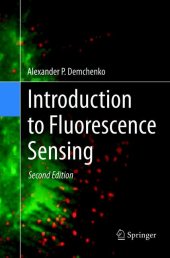 Neuerscheinungen 2019Stand: 2020-02-01 |
Schnellsuche
ISBN/Stichwort/Autor
|
Herderstraße 10
10625 Berlin
Tel.: 030 315 714 16
Fax 030 315 714 14
info@buchspektrum.de |

Alexander P. Demchenko
Introduction to Fluorescence Sensing
2. Aufl. 2019. xxxi, 794 S. 66 SW-Abb., 236 Farbabb., 12 Tabellen. 235 mm
Verlag/Jahr: SPRINGER, BERLIN; SPRINGER INTERNATIONAL PUBLISHING 2019
ISBN: 3-319-79318-7 (3319793187)
Neue ISBN: 978-3-319-79318-4 (9783319793184)
Preis und Lieferzeit: Bitte klicken
Fluorescence is the most popular technique in chemical and biological sensing and this book provides systematic knowledge of basic principles in the design of fluorescence sensing and imaging techniques together with critical analysis of recent developments. Its ultimate sensitivity, high temporal and spatial resolution and versatility enables high resolution imaging within living cells. It develops rapidly in the directions of constructing new molecular recognition units, new fluorescence reporters and in improving sensitivity of response, up to the detection of single molecules. Its application areas range from the control of industrial processes to environmental monitoring and clinical diagnostics. Being a guide for students and young researchers, it also addresses professionals involved in basic and applied research. Making a strong link between education, research and product development, this book discusses prospects for future progress.
Chapter 1. Introduction
Chapter 2. Basic principles
2.1. Overview of strategies in molecular sensing
2.2. Labeled targets in fluorescence assays
2.3. Competitor displacement assays
2.4. Sandwich assays
2.5. Catalytic biosensors
2.6. Direct reagent-independent sensing
Sensing and thinking: How to make the best sensor? Comparison of basic principles
Chapter 3. Theoretical aspects
3.1. Parameters that need to be optimized in every sensor
3.2. Determination of binding constants
3.3. Modeling the ligand binding isotherm
3.4. Kinetics of target binding
3.5. Formats for fluorescence detection
Sensing and thinking: How to provide the quantitative measure of target binding?
Chapter 4. Fluorescence detection techniques
4.1. Fluorescence fundamentals
4.2. Intensity-based sensing
4.3. Anisotropy-based sensing and polarization assays
4.4. Lifetime-based fluorescence response
4.5. Excimer and exciplex formation
4.6. Förster resonance energy transfer (FRET)
4.7. Wavelength-shift sensing
4.8. Two-band wavelength-ratiometric sensing with a single dye
Sensing and thinking: The optimal choice of fluorescence detection technique
Chapter 5. Molecular-size fluorescence emitters
5.1. Fluorophores and their characteristics
5.2. Organic dyes as labels and tags
5.3. Organic dyes as fluorescence reporters
5.4. Visible fluorescent proteins
5.5. Luminescent metal complexes
5.6. Few-atom clusters of noble metals
Sensing and thinking: Which molecular reporter to choose for particular needs?
Chapter 6. Nanoscale fluorescence emitters
6.1. Introduction to light emitting nano-world
6.2. Dye-doped nanoparticles and dendrimers
6.3. Conjugated polymers
6.4. Fluorescent carbon nanostructures
6.5. Semiconductor quantum dots
6.6. Up-converting nanocrystals
Sensing and thinking: Nanoscale emitters, what are the advantages?
Chapter 7. Fluorescent nanocomposites
7.1. Fluorescence enhancement and quenching in nanocomposites
7.2. Modulation of emission parameters in multi-fluorophore systems
7.3. Optical choice of FRET donors and acceptors
7.4. Wavelength referencing, multiplexing and multicolor coding
7.5. Combining fluorescence with magnetic, NMR enhancing and other functionalities
Sensing and thinking: Achieving multitude of functions in designed nanocomposites
Chapter 8. Recognition units
8.1. Multivalency: the principle of molecular recognition
8.2. Recognition units built of small molecules
8.3. Antibodies and their recombinant fragments
8.4. Ligand-binding proteins and protein-based display scaffolds
8.5. Designed and randomly synthesized peptides
8.6. Nucleic acid aptamers
8.7. Peptide nucleic acids
8.8. Molecularly imprinted polymers
Sensing and thinking: Selecting the tools for optimal target recognition
Chapter 9. Mechanisms of signal transduction
9.1. General principles of signal transduction
9.2. Basic signal transduction mechanisms: electron, charge and proton transfer
9.3. Signal transduction via excited-state energy transfer
9.4. Superenhancement and superquenching
9.5. Signal transduction via conformational changes
9.6. Signal transduction via association and aggregation phenomena
9.7. Smart sensing with logical operations
Sensing and thinking: How to couple the recognition and reporting functionalities?
Chapter 10. Supramolecular structures and interfaces for sensing
10.1. Self-assembled supramolecular systems10.2. Building blocks for supramolecular sensors
10.3. Conjugation, labeling and cross-linking.
10.4. Supporting and transducing surfaces.
10.5. Functional lipid and polymer bilayers
Sensing and thinking: Extending sensing possibilities with smart nano-ensembles
Chapter 11. Non-conventional generation and transformation of response
11.1. Chemiluminescence and electrochemiluminescence
11.2. Bioluminescence
11.3. Radioluminesc


